Remember back in April when signs were posted that bike lanes were coming to Broadway? Remember back in 2008 when it was first announced that they were coming? Don’t worry, no one does.
They are here now”¦ almost. Just in time for a snow storm, we have the guides laid down on Broadway’s fresh pavement for bike lanes:
Of course, as Car-Free in PVD points out, the bike lanes are in the dreaded door zone. If you ride to the right of the lane, which as Car Free points out, Rhode Island Law instructs cyclists to do, then you are gonna get doored. There is room to stay the the left side of the lane and avoid the door.
Ideally, we would have protected bike lanes, but these lanes were put in on the cheap. As part of the repaving project, basically just some paint was all that was needed to make these lanes on Broadway appear. In our cash strapped city-state”¦ I don’t want us to have to settle for less all the time, but this is a good get.
In New York, they’ve been all about bike lanes for a while now, and they’ve got some good infrastructure going, I took some photos when I was in the City earlier this month .
Bike lane on 9th Avenue at West 23rd Street in Manhattan.
Here we see the bike lane on 9th Avenue. The lane runs between the sidewalk and parked cars, with a buffer between the parked cars and the bike lane, eliminating the door zone problem. The lane helps pedestrians too as a travel lane was removed for the bike lane and a pedestrian refuge was built in the parking lane at the intersections. This makes 9th Avenue two lanes narrower than it was before shortening the distance pedestrians have to traverse on the light.
Unfortunately, if you look very closely, you can see a white van parked in the bike lane, sigh.
Bike lane on 9th Avenue at West 30th Street in Manhattan.
Further up 9th Avenue we see a left turn bay. Auto traffic leaving 9th Ave. to turn onto 30th moves into the bike lane and shares the lane with the bikes (you can see a Sharrow on the pavement).
The next photo is looking in the opposite direction at the same intersection as the previous one. Again you can see the pedestrian refuge and the parking between the bike lane and travel lanes. Stanchions in the roadway separate the parking lane from the bike lane.
Bike lane on 9th Avenue at West 30th Street in Manhattan.
The next photo is 8th Avenue at Penn Station.
Bike lane on 8th Avenue at West 31st Street in Manhattan.
Here the lane is painted, there is a parking lane and buffer between the parking and bike lanes, but no stanchions. I’m standing on the pedestrian refuge and you can see that the refuge a tree planted in it.
Next photo is the same intersection looking the other way.
Bike lane on 8th Avenue at West 31st Street in Manhattan.
These are just some of the configurations that New York and other cities are implementing. For Providence it is baby steps. But really, having bike lanes on Broadway, even if they are minimal paint on the road and have door zone issues, is a big step. That is a lot of real estate that is covered and sends a big message that the city is starting to take multi-modalism seriously, let’s continue to encourage it.

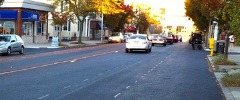
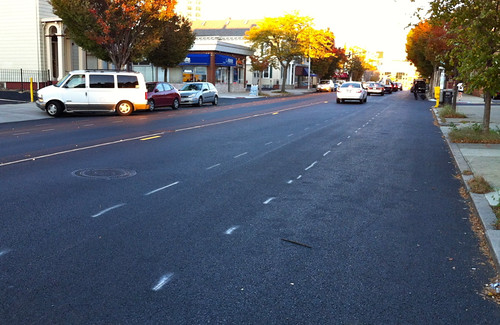
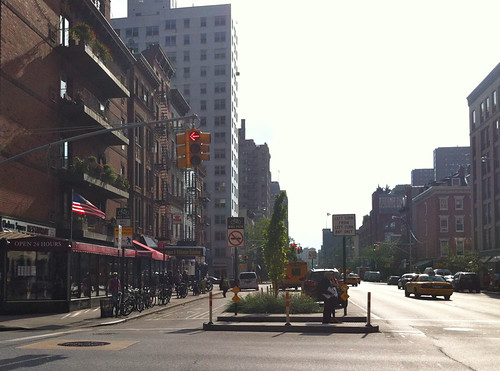
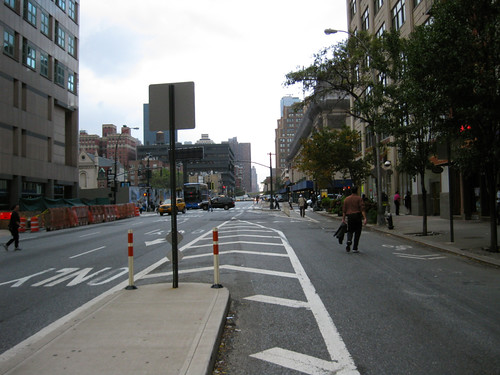
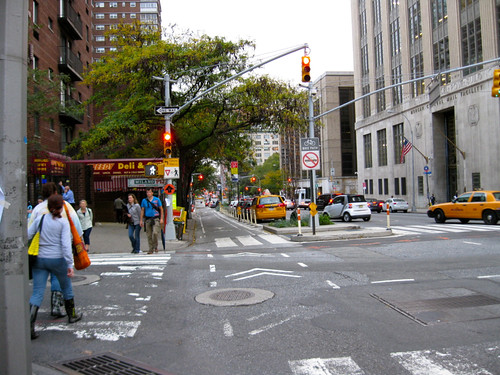
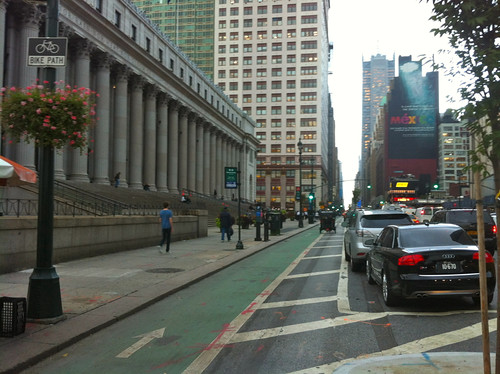
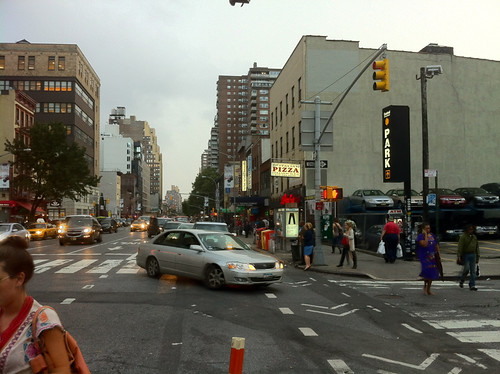
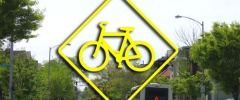


The partial doorzone issue does bother me. It’s not hard to avoid if you know what you are doing. There is one important thing these lanes get right: At one point (closer to the Olneyville side), there is a straight-ahead lane and a right-turn only lane for cars. The bike lane goes right between them. This will help cyclists avoid right hook issues. Since it took 6 weeks to strip and repave Broadway, I wonder how long it will take them to lay down the paint? I look forward to documenting it once it’s done.
I think that the jury is still out on New York’s protected bike lanes. There have been repeated and sometimes horrific accidents as a result of the protected lanes and to some degree with the standard bike lane similar to the new Broadway lanes.
For years I’ve split my time between Manhattan and Rhode Island, so perhaps I can offer a local perspective. Not all avenues are created equal. Cartways, the distance between curbs varies. Ninth Avenue is able to offer more generous space for all using the cartway. Second Avenue is more constrained.
With both bike riders and drivers the specialized traffic signals for each can be confusing, especially for out-of-towners. Often both drivers and bike riders run the light at the left side of the avenue. Pedestrians tend to jaywalk or wait off the sidewalk in the road to cross an intersection.
Maybe it was a year ago the sister of the Harvard lawyer Alan Dershowitz was riding behind her husband in the Ninth Avenue bike lane when a van ran the light to make a left turn and killed her. Last weekend two friends of mine were talking at the southeast corner of Second Avenue and East 10th Street, when they saw a frail elderly woman put one foot off the curb into the bike lane, when a rider flew through the intersection and hit the woman, flinging her into the air. She landed on her head. People rushed out of a juice bar with paper towels attempting to stop the bleeding of her head before EMS arrived. Others on the sidewalk tackled the bike rider as he was trying to escape. On the unprotected St. Marks Place bike lane a Cooper Union student was hit by a dump truck who wasn’t paying attention, She was in a coma for six week, broke many of the bones in her body, but oddly is more or less recovered today.
Sorry to be so New York Post in these examples, but the bike lanes have been a mixed bag with thousands benefiting from bike lanes and other becoming victims of them.
It is generally agreed that 3- to 4-feet are needed to avoid the door zone from a bike lane. Average car widths ar between 5- and 6-feet wide. If the Broadway parking lane is 8-foot, the Broadway bike lane clearance would be close to acceptable. I agree with Jef that this is a great start for Providence. Since the city has been so late in creating bike lanes it becomes an opportunity to learn from other cities before implementing a citywide system.
Peter, I don’t see how your examples are a result of the bike infrastructure. They were either due to carelessness, or could have easily happened without the bike facility.
Did the rider who hit the elderly woman run a red light? Would it have been avoided if she looked both ways before stepping into the bike lane, much like we would expect her to do before stepping into car traffic? The dump truck wasn’t paying attention, and the van ran the red light.
Unidirectional bike lanes on either side of the street are great because they preserve the standard layout of the road that everyone’s used to – I’m glad that’s what we have on Broadway.My biggest problem with protected bike facilities, and this is a documented phenomenon, is too much separation; cyclists and drivers forget about each other until the intersection, where it’s too late. I like configurations that either allow right-turning drivers to merge over or into the bike lane well before an intersection, or at least emphasize visibility between the two. If Broadway was to have physically separated lanes, then they would have to be between parked cars and the sidewalk, but parking would have to be prohibited well before the intersections and the alignment should follow something like the cycle-tracks in DC: http://farm7.static.flickr.com/6218/6288720643_a594bf7b74_b.jpg
I don’t actually know if those have proved to be effective, but I like the idea.
Great post GC PVD!
I’m for an incremental approach with cycling infrastructure. The first steps should be the simple ones – the no brainers like striping Broadway. The striping sends the message that cyclists will be here. Most drivers will be aware enough to give an extra look before opening their door, but that doesn’t mean that cyclists should feel protected here. Cyclists who are currently out there have a certain awareness that should be maintained even while traveling between two painted stripes and should be prepared to improvise accordingly. New and prospective cyclists should respect that that there is a learning curve when riding in the urban environment regardless of the paint on the road. When more of our car drivers are also bicycle drivers, we will have a city that is ready for the more advanced infrastructure.
Good points, Jack. Education is essential! Certain things like the door-zone seem obvious to people who have spent some time cycling, but might not be so clear to people just starting. Didn’t NYC periodically distribute a pamphlet along their new facilities that gave tips on stuff like that? Not a bad idea. (It was probably also stuffed with not-so-subtle propaganda about red lights etc. but we won’t get into that here..)
Also, to add to my earlier post about protected bike lanes, it could be argued that they introduce other problems like high differentials in speed between cyclists and drivers. Definitely are kinks.
The accident with elderly woman was in part due to bike infrastructure. Prior to the improvements, if she stepped into the roadway she would have been protected by parked cars lining the curb. Especially with Second Avenue there is no dimensional buffer between the bike lane and the sidewalk curb, plus there are far more pedestrians on Second Avenue as compared to Ninth Avenue. The cyclist did run the light, which raises another point, it’s human nature whether driver, cyclist, or pedestrian to try to get through an intersection before they are technically allowed in order to save time, even if it means running the light. The possible exceptions might be Seattle and Tokyo where people dutifully wait for a green signal before moving on.
Then Peter, by your reckoning, all vehicular traffic should be illegal because there’s always a chance someone will make a mistake or a bad choice that will result in someone else being injured.
Tom makes a good point that separated bike lanes make everyone too complacent until the intersection. The bike lanes on Broadway as is give cyclists agency: they have a designated area, forcing motorists to reduce their speed and consider the cyclist. Realistically, I’m not sure what else RIDOT could have done here, except put the bike lane between the sidewalk and the parked cars…which is a colossally bad idea!
I wonder if the traffic code needs to be changed so that vehicle operators are liable for all accidents with vehicles smaller then themselves, even if the smaller vehicle is at fault. I’m thinking bikes are responsible for pedestrians, cars are responsible for bikes and pedestrians, etc. Even though this may give cyclists excuse to run every light because if they get hit it will always be the driver’s fault (or maybe not, because if they get hit, they’ll be dead), but it at least would make motorists watch the “little guy” if they’re held responsible.
Despite living on Broadway, commuting daily by bike on Broadway, and being a car-owner with a driveway on Broadway, this is the first I’ve heard of the bike lanes.
I was delighted to see the guides painted a week or two ago, and hoped this was the intent — but I wonder how the city plans on educating drivers that these bike lines exist, and helping to correct drivers’ frequent assumptions that Broadway is a four-lane roadway. This concerns me far more than the prospect of being doored. I haven’t seen any signage indicating the new guides are for designated bike lanes, and since their appearance a week or so ago, I’ve seen drivers continue to ride right over them — abreast of adjacent cars. (I do realize that the lanes are not yet completed, but the guides seem to not be giving drivers any pause thus far.) RIPTA bus drivers are some of the worst offenders — a terrifying reality.
A couple of weeks ago, an associate who works on Broadway noted that I \”risk [my] life by biking down Broadway to work [on the East Side] every day\” — and he’s right. Traffic rules seem to not apply, and drivers do not notice, understand, or bother to care about my hand signals. Fellow cyclists are just as frightening — often biking down the opposite side of the street, failing to stop at lights or signs, and not yielding to the right-of-way. I am a respectful, traffic-abiding cyclist — yet since May alone, I have been run off Broadway twice, shouted at to \”get on the sidewalk\” numerous times, and had a lit cigarette intentionally thrown into my lap. Conversations with fellow cycling commuters reveal similar incidents.
My hope is that Providence will proactively launch a campaign to educate drivers and cyclists to share the road safely, and I hope the city will prominently mark these lanes as designated for bike traffic. My native city of Portland, OR, has done both to great success: http://www.thingsaregood.com/2010/04/05/portland-bike-lanes-keep-improving/
The bike lanes are a step in the right direction. I hope it’s a well-considered step.
But at least they put in induction sensors that can detect bicycles at Broadway and Knight and I think they’re doing them over at the double set of lights too.
Andrew, I’m not suggesting that there should be no bike infrastructure or that motor vehicles should be banned. My point is that locating a separated bike lane immediately next to a sidewalk with no buffer needs to be considered carefully, because it can be dangerous. Besides pedestrians and drivers are still not used to them in New York two years after they were first introduced.
The separate signals for bikes and cars that New York uses on avenues could actually be more dangerous than if both travel modes used the same signal. I also agree with Tom that the new Broadway bike lanes are probably safer.
An improvement could be to reduce the travel lane width for cars by a foot or so to allow the bike lane to be shifted away from the door zone of the parking lane, making it safer for bike riders. However, if the bike lane and door zone buffer becomes too wide, it could be perceived as an additional lane by aggressive drivers who would drive over it.
I didn’t see the actual guidelines painted on the street. Does anyone know whether the guidelines showed a bike reservoir space between crosswalks and the stop line for cars? A bike reservoir would make it easier for cyclists to make left hand turns and add another element of safety.
Geneveive’s suggestion of an education program for drivers would help with bike safety. Maybe it could be expanded to include RIPTA drivers.
A lot of good ideas above. I would also note: statistical evidence exists indicating that the more bicyclists, the lower the per-mile risk to a bicyclist as other road users get used to bikes on the road. Similarly, anecdotaly, I’ve noticed more considerate drivers in the East Bay where the path has led to more bicyclists, no doubt often including the motorists or someone in their family. Also, last session the legislature considered a bill by Senator Sosnowski enhancing penalties if a careless motorist kills or injures a bicyclist or other vulnerable road user (pedestrian, wheelchair user, highway worker etc) and though it didn’t pass the RI Bike Coalition is hoping to try again.
Are there any bike education questions asked as part of drivers education courses in RI? I know other states are starting to implement at least a base level of knowledge to young drivers as bike infrastructure becomes more common. It’s also struck me as I’ve sat and waited for hours on end at the DMV that the State could be running educational programming in the waiting area rather than mindless pop-culture trivia.
“…pedestrians and drivers are still not used to them in New York two years after they were first introduced.”
Should we just give up because it is too much to expect people to acquire the habit of looking both ways before stepping into a bike lane? In NYC, bike share will get a lot more bikes onto the streets and bike lanes. The riders will no longer be only those strange creatures, committed cyclists. Everyone will get used to it.
Nothing not to like about bike lanes on Broadway, but perspective, please. Some paint on a street that was already one of the easier places to ride is really a laughably tiny amount of progress.
I will be impressed when they do something so an average cyclist will dare to cross the Dean Street or Branch Avenue overpasses. How about a decent route from downtown to the West Bay bike path? It might take more than paint.
I like Andrew I’s fightin’ words. A simple-sound goal: allowing cyclists to ride across the state, through Providence, without leaving bicycle infrastructure, could be really helpful. Connecting two bike paths (or three) through Providence so that the average cyclist wouldn’t be intimidated would be amazing.
@ Smack.
About a year ago, the RIDMV introduced an insert into the latest edition of the drivers manual that introduced some bicycle/driver safety information. At the next printing, it will be introduced into the manual permanently and a question will be introduced into the written exam. This was a RI Bicycle Coalition effort with the RIDMV. Check us out @ http://www.ribike.org